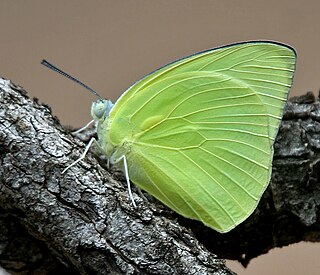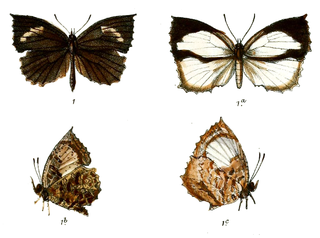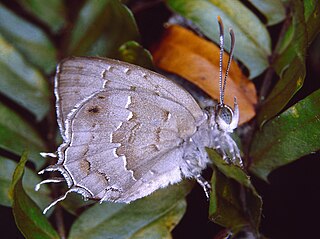Related Research Articles

Euthalia aconthea, the common baron, often called simply baron, is a medium-sized nymphalid butterfly native to Sri Lanka, India and southeast Asia. It flies with stiff wing beats and often glides. The wing is not flapped very far below the horizontal.

Catopsilia pomona, the common emigrant or lemon emigrant, is a medium-sized pierid butterfly found in Asia, Cambodia and parts of Australia. The species gets its name from its habit of migration. Some early authors considered them as two distinct species Catopsilia crocale and Catopsilia pomona.

Miletus symethus, the great brownie, is a small butterfly found in India that belongs to the lycaenids or blues family. The species was first described by Pieter Cramer in 1777.

Allotinus drumila, the crenulate darkie, is a small butterfly found in India, Burma, Thailand, Laos, Vietnam, and Yunnan (China) that belongs to the lycaenids or blues family.

Surendra vivarna, the acacia blue, is a species of lycaenid or hairstreak butterfly found in Sri Lanka, India and the Indonesian islands as far as Sulawesi.
Helcystogramma heterostigma is a moth in the family Gelechiidae. It was described by Alexey Diakonoff in 1967. It is known from the Philippines (Luzon).
Tonica citrantha is a moth in the family Depressariidae. It was described by Alexey Diakonoff in 1967. It is found on Luzon in the Philippines.
Stenoma recondita is a species of moth of the family Depressariidae. It is found in Guyana.
Cerconota eriacma is a moth of the family Depressariidae. It is found in Guyana.
Stenoma peccans is a moth of the family Depressariidae. It is found in the Amazon region and French Guiana.
Antaeotricha tremulella is a species of moth of the family Depressariidae. It is found in the Guianas and Brazil.
Antaeotricha bicolor is a species of moth of the family Depressariidae. It is found in Brazil.
Deltoplastis apostatis is a moth in the family Lecithoceridae. It was described by Edward Meyrick in 1932. It is found in Japan.
Thymiatris microloga is a moth in the family Xyloryctidae. It was described by Alexey Diakonoff in 1966. It is found on Java.
Agriophara hyalinota is a moth in the family Depressariidae. It was described by Oswald Bertram Lower in 1899. It is found in Australia, where it has been recorded from South Australia and Queensland.
Antaeotricha semicinerea is a moth in the family Depressariidae. It was described by Philipp Christoph Zeller in 1877. It is found in Panama, Guatemala and Brazil (Amazonas).
Antaeotricha orthriopa is a species of moth in the family Depressariidae. It was described by Edward Meyrick in 1925. It is found in Brazil.
Stenoma symmicta is a moth in the family Depressariidae. It was described by Lord Walsingham in 1913. It is found in Panama and Guyana.
Imma thyriditis is a moth in the family Immidae. It was described by Edward Meyrick in 1906. It is found on the Solomon Islands.
Moca aphrodora is a species of moth in the family Immidae first described by Edward Meyrick in 1922. It is found in Brazil and Peru.
References
| This Tineidae-related article is a stub. You can help Wikipedia by expanding it. |